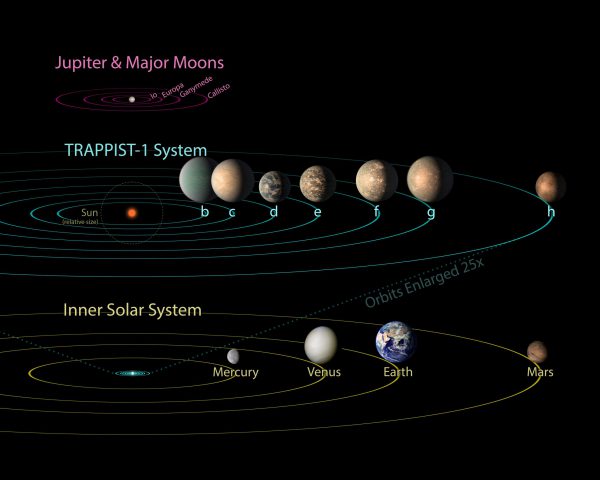May 7 to 22 is Science Odyssey, a celebration of all things science! OWLconnected is recognizing this two-week event with lots of science content, as well as with an amazing contest, presented by our friends at the Natural Sciences and Engineering Research Council of Canada (NSERC). Details are at the end of this post—be sure to enter!
So many worlds, so little contact
Humans sure do love talking about aliens. But will we ever make contact with any in real life? (Getty Embed)
When you look at some of the biggest films in the world, many of them have one thing in common.
Alien worlds.
From Star Wars to Marvel to the upcoming Lightyear, we can't get enough of stories of spaceships hopscotching from planet to planet, galaxy to galaxy, all in the blink of an eye, as races from across the universe come together in endless feats of exploration and conflict. EPIC ADVENTURE!
But in real life, the opposite is true. Sure, there are plenty of worlds out there, and we're discovering more all the time. But they are so far away. If we got in our fastest spacecraft right now, it would us 73,000 years to just get to the nearest one.
So, no alien worlds for us?
The search is on
While the likelihood of a human leaving the solar system any time soon is basically zero, it doesn't mean that we're not trying to find some way to reach out to other worlds.
The first is the search for exoplanets—these are planets outside our solar system. So far, we've discovered thousands.
The second is something called SETI—the Search for ExtraTerrestrial Intelligence. This has been going on since at least the 1960s and involves scanning the skies for patterns in electromagnetic radiation that aren't natural. In other words, signals made by the technology of advanced aliens.
We're over here!

M13, a cluster of stars that we messaged back in 1974. The message should get there in... 25,000 years! What? (Wikimedia Commons)
And the third is METI. This is Messaging ExtraTerrestrial Intelligence. In this quest, we're the ones sending out the signal, hoping that another alien race out there is listening in.
We've tried this in the past, in a few different ways. Launched in the 1970s, several of the Pioneer and Voyager spacecrafts have each carried different plaques (and even a record) with images, recordings, and codes giving details about humanity and Earth. It is a cool idea, but an alien explorer to find one of these would be like finding a needle in 4 billion haystacks.
Then there is the idea of sending out focused radio messages. (Radio waves are a type of electromagnetic radiation.) This is also something that we've done before. In 1974, the Arecibo Observatory in Puerto Rico beamed out a message that contained information about Earthlings to M13—a huge cluster of stars in the Milky Way, 25,000 light years from Earth.
Since the 1970s, these attempts have died down, as space scientists focused more on other projects. But in the next 12 months or so, we're going to try harder than ever to say 'Hi!' to aliens.
Broad 'Beacon'
China's enormous FAST radio telescope. (Getty Embed)
A group of scientists are taking the idea of the Arecibo message and updating it. Called 'The Beacon in the Galaxy', it contains a similar, though much more complex, code that attempts to explain lots about Earth. Numbers, chemistry, humanity, and so much more. It will be sent from the brand new Five-hundred-meter Aperture Spherical radio Telescope, or FAST, found in southwest China.
This time, the target is a group of millions of stars near the centre of the Milky Way. One of these places has got to have advanced life, right?
The main issue with both this attempt and Arecibo is that these places are so far away. It could be tens of thousands of years before we ever hear a reply. Would anyone even remember humans sent the message in the first place?
Dear TRAPPIST-1...

A comparison between the solar system of TRAPPIST-1 and our own. (NASA/JPL-Caltech)
That's what makes this second new attempt more interesting.
On October 4, 2022, a group of English astronomers at the Goonhilly Satellite Earth Station are going to send a message to a very specific location. Instead an area of millions of stars farther away, their target is a single star. TRAPPIST-1.
We already know quite a bit about this star. It has seven planets in its solar system. And three of these planets are found within the so-called Goldilocks zone. This is an area around a star that should be the right distance from it to have liquid water, and maybe support life. Like Earth!
And TRAPPIST-1 is just 39 light years away. Okay, that is still super far! But for a radio wave, which can travel the speed of light, we could hear back in 78 years (2090). So within a single human lifetime.
It's a long shot
Of course, both of these new attempts are long shots. The chances of us finding alien life, and of that alien life actually listening, and of that alien life being able to translate our message, AND of us being prepared enough to hear their reply at some mysterious point in the distant future? Well, let's just say that a lot of stuff needs to go right.
(And, according to some experts, it's maybe something that we shouldn't be focusing on at all...)
But just because it seems impossible doesn't mean we can't try! That's what so much of science is all about. If you could talk to aliens, what would you say?
Contest alert
Don't forget to enter the Science Odyssey Contest! CLICK HERE TO ENTER.

 Our galaxy alone—the Milky Way—has billions upon billions of stars. But that doesn't mean finding life in it is going to be easy. (ID 11076000 © Marco Beretta | Dreamstime.com)
Our galaxy alone—the Milky Way—has billions upon billions of stars. But that doesn't mean finding life in it is going to be easy. (ID 11076000 © Marco Beretta | Dreamstime.com)









